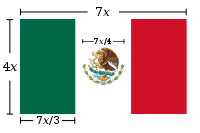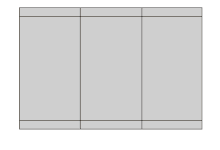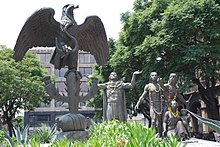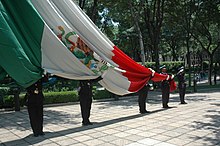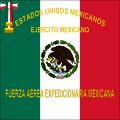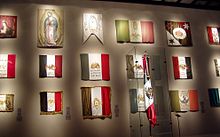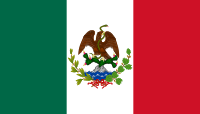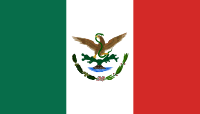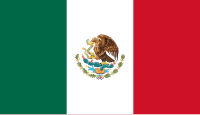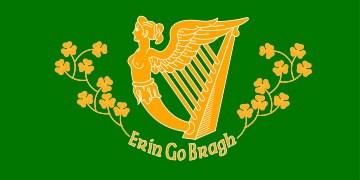Mexican flag
The Flag of Mexico, officially called the National Flag of the United Mexican States, is one of the three national symbols established by law in that country, along with the coat of arms and national anthem. The current design of the flag was adopted on September 16, 1968 and since February 1984 its use is regulated by the Ministry of the Interior based on the Law on the National Coat of Arms, Flag and Anthem in the second chapter. It is segmented into three equal parts, each one of a different color starting from the pole (green, white and red) and with the coat of arms of Mexico in the center of the white stripe. It is one of the most significant patriotic symbols of this nation, its day is celebrated on February 24. Under the title "Of the characteristics of the national symbols" It is described in a general way within the aforementioned law:
ARTICLE 3. The National Flag consists of a rectangle divided into three vertical strips of identical measures, with the colors in the following order from the top: green, white and red. In the white strip and the center, it has the National Shield, with a diameter of three quarters of the width of the strip. The ratio between width and length of the flag is four to seven. You can wear a tie or tie of the same colors, at the foot of the moharra.
Description
There are basically two types of Mexican flag: the one commonly known for official use and the other for civil use, which are regulated based on articles 3, 32 and 33 of the Law on the shield, flag and national anthem.
Official flag
The official or commercial flag regulated by articles 3 and 33 of the Law on the National Shield, Flag and Anthem, whose basic characteristic is that it must bear the model shield that has been reproduced in triplicate and deposited a replica in the General Archive of the Nation, another in the National History Museum and another replica in the Mint.
ARTICLE 3. The National Flag consists of a rectangle divided into three vertical strips of identical measures, with the colors in the following order from the top: green, white and red. In the white strip and the center, it has the National Shield, with a diameter of three quarters of the width of the strip. The ratio between width and length of the flag is four to seven. You can wear a tie or tie of the same colors, at the foot of the moharra.
A model of the National Flag, authenticated by the three powers of the Union, will remain deposited in the General Archive of the Nation and another in the National History Museum.
- Link to a photograph of the authenticated model of the National Flag under the guard of the General Archive of the Nation
ARTICLE 33. The copies of the National Banner for trade must adhere to the provisions of article 3 of this order.
Civil flag
The flag for civil use, on the other hand, must bear the coat of arms in one ink. It is understood that it is on a white background with black lines to draw the coat of arms, but it does not clearly indicate if it is a single color version of the model coat of arms or the ink version to be reproduced on paper.
ARTICLE 32. Physical persons may use the National Flag in their vehicles or exhibit it in their places of residence or work, provided that they observe the respect that corresponds to that Patriot Symbol. In these cases, the National Flag may be of any dimension.
General characteristics
In any of the previous cases, the flag consists of a rectangle divided into three vertical stripes of equal proportion, of green, white and red colors (left to right) ordered from the pole. Its length-width ratio is four to seven (4:7).
In the center of the white stripe is the National Coat of Arms of Mexico, with a diameter of three quarters of the stripe, and consists of a Mexican eagle devouring a snake that it maintains supported with its beak and claw of his right paw; the eagle is perched on a cactus located on an islet on Lake Texcoco represented by a Nahuatl glyph. The shield is based on the Mexica legend that tells how its people wandered for hundreds of years in Mexican territory looking for the sign indicated by their gods to found the city of Tenochtitlán (present-day Mexico City), where they saw an eagle devouring a a snake.
Although the meaning of the colors has changed over time, they were adopted by Mexico during the War of Independence with Spain. The current flag was officially adopted in 1968, but the general design has been used since 1821 when the first national flag was created. Since Wednesday, February 8, 1984, there has been a law published in the Official Gazette of the Federation that governs and regulates the use of the National Flag called Ley sobre el Escudo, la Bandera y el Anthem Nacionales. The flag has changed thirteen times throughout its history (based on the Miguel Hidalgo banner), as the design of the National Shield and the proportions of length and width have been modified. The current flag, called the Fourth National Flag, is also used as a naval symbol by all ships registered in Mexico.
Colors and their meaning
The exact official colors of the flag have not yet been defined by Mexican law, but the Ministry of the Interior suggests using the following; Based on the Pantone system, approximate equivalencies in other color systems are provided:
| Color system | Green | White | Red | |||
|---|---|---|---|---|---|---|
| Pantone | 3425c | Safe | 186c | |||
| RGB | 0-104-71 | 255-255 | 206-17-38 | |||
| CMYK | 100-34-93-30 | 0-0-0-0-0 | 0-92-82-19 | |||
| RGB Hex. | 006847 | FFFFFF | CE1125 | |||
Popular belief says that the colors of the flag originated in the flag of the Army of the Three Guarantees or «Bandera Trigarante», in 1821, but as the form or method of selection is at least uncertain. Some, for example, believe that it is a copy of the colors of the Italian flag, since the Italian flag originates from a banner with those same colors that was delivered by Napoleon in November 1796 to a body of Italian volunteers from the Lombard Legion.. Another much more accepted theory is that the colors were born among the insurgents of the southern zone of Mexico, since after 1815 several flags with the three colors are known and in the known order, the most famous is the so-called Bandera Siera, considered the first tricolor flag of the insurgent hosts and that guided a group of cavalry from the troops of Nicolás Bravo, but there are others, one of them was taken from José María Morelos when he was captured, this one has a Mexican eagle as a shield on the which is placed a Virgin of Guadalupe. Another popular saying is that the original meaning of the colors was popularly defined by Agustín de Iturbide based on point 16 of the "Plan or Indications for the government" in the Plan of Iguala, which says:
16.- It will form a protective army that will be called of the Three Guarantees, because under their protection it takes, first, the preservation of the Catholic, apostolic, Roman religion, cooperating for all the ways that are at their disposal, so that there is no mix of any other sect and the enemies that can harm it are attacked in due course: the second, the independence under the manifested system: the third, the intimate union of Americans and Europeans; for it will guarantee the fundamental bases of the last violation of Spain.
But he never links his words to the colors, so there is no official meaning, the colors have been popularly associated as follows:
- White: Religion (the Catholic faith) and purity of the ideals of the people
- Red: Union (between European and American)
- Green: Independence (Independence of Spain)
This first meaning was changed in the middle of the XIX century due to the secularization of the country, led among other liberals by the then president of Mexico, Benito Juárez. The meaning attributed at that time was:
- Green: Hope.
- White: Unit.
- Red: The blood of national heroes.
Specifically, as article 3 of the Law on the National Coat of Arms, Flag and Anthem does not give an official symbolism of the colors, they can be attributed and have been attributed a multitude of meanings.
Common Flag Design Mistakes
A common mistake is to assume that, when building the Mexican flag, the Mexican National Shield was simply placed in the center of the white stripe of the Italian flag. However, Italy did not yet exist as an independent country when Mexico already had its flag. Therefore, there is no way that the flag of Mexico is based on the flag of Italy. In any case, the confusion also occurs because some people incorrectly believe that the only difference between the two flags is the national shield present in the Mexican tricolor.
Both flags bear similar colors, but the flag of Mexico uses darker shades of green and red. More important, however, are the different ratios of length and width in each flag, which gives them a unique look. While the Italian flag maintains a 2:3 aspect ratio, the Mexican flag has a 4:7 aspect ratio, which gives it a more elongated appearance.
The Shield
The shield is positioned in the center of the white stripe and is inspired by the sign of the end of the Mexica pilgrimage where they would later found Mexico City-Tenochtitlán, present-day Mexico City. According to the religious beliefs of the Mexicas, they had left Aztlán looking for the right place to build their new city. The god Huitzilopochtli told them that in the place where they found an eagle devouring a snake standing on a cactus, they should build their city. After 200 years of searching for that place, the Mexicas found the sign on the islet of Tlacocomolco in Lake Texcoco.
The current design of the National Shield is the work of the architects Pedro Moctezuma Díaz Infante and Francisco Eppens Helguera, and consists of an eagle in profile on the left side, displaying the upper part of its wings in a combat attitude; with the fallen plumage touching the tail and its feathers in a natural fan. His left claw resting on a flowered cactus that rises on a rock that emerges from a lake, holding with the right and with the beak, in an attitude of devouring, a curved snake, so that it harmonizes with the whole. Several cactus stalks branch at the sides. Two branches, one of oak in front of the eagle and the other of laurel on the opposite side, form a lower semicircle between them and are joined by means of a ribbon divided into three stripes that, when the National Shield is represented in natural colors, correspond to those of the National Flag.
During the Mexican war of independence, the symbol of the eagle and the serpent was not entirely favored. Miguel Hidalgo y Costilla, for example, preferred the use of the image of Our Lady of Guadalupe, and Ignacio Allende ordered a couple of flags to be made before the start of the War of Independence, on whose faces the crowned image of Our Lady of Guadalupe was displayed in front as symbol of the union of all New Spain society and on the reverse a kind of shield with the eagle and the serpent, but flanked by Spanish flags with the Cross of Burgundy. Of both symbols, the eagle and the serpent was the one that prevailed, above all because of its ability to become a secular symbol. Since then it has been used on different banners and official seals of the insurgents, such as the official seals and war flag of the Supreme National American Board or Supreme Government Board of America and the Anahuac Congress, from which the very popular personal flag of the generalissimo was derived. Jose maria morelos and pavon. After that, the emblem of the eagle and the serpent became the preferred and official emblem of the Mexican people,[citation required] whose general description is contained in article 2 of the Law on the National Coat of Arms, Flag and Anthem which says:
The National Shield is made up of a Mexican eagle, with the exposed left profile, the upper part of the wings on a higher level than the plume and slightly deployed in combat attitude; with the downward supporting plumage touching the tail and feathers of this in natural fan. He puts his left claw on a flourishing nopal that is born in a rock that emerges from a lake, subject with the right and with the beak, in devouring attitude, to a curved serpent, so that it harmonizes with the set. Several penks of the nopal branch to the sides. Two branches, one of the oaks in front of the eagle and another of the laurel on the opposite side, form between both a lower semi-circle and join by means of a strip divided into three stripes which, when the National Shield is represented in natural colors, correspond to those of the National Flag.
Protocol
When the flag is paraded in front of a group of people, those in military uniform must present a salute according to their regulations (according to article 9 and article 14 of the Law on the coat of arms, flag and national anthem Mexican). The civilians present must salute the national flag as follows: standing at attention, the civilian raises his right arm and places his right hand on his chest, in front of his heart. His hand should be open and his palm facing the floor. The salute is known as the "Civil Salute to the National Flag". When the president is in the capacity of Supreme Commander of the Armed Forces , he salutes the national flag with a military salute. When the National Anthem is played on television to open or close daily programming, the flag must be displayed at the same time.
Art. 15 of the Law on the National Shield, Flag and Anthem states that in the buildings of the Authorities and Institutions that provide educational services, honors must be paid to the National Flag on Mondays, at the beginning of the work or at a time that the Authorities and Institutions themselves determine on that day, as well as at the beginning and end of the school year.
The Federal, State and Municipal Education Authorities will provide that in the elementary, middle and upper education institutions, honors are given to the National Flag on Mondays, at the beginning of schoolwork or at an hour determined on that day in the morning, as well as at the beginning and end of courses.
Flag Day in Mexico is celebrated on February 24. On the same day of 1821, all the parties fighting in the Mexican War of Independence joined forces to form the Army of the Three Guarantees as proposed by the Plan of Iguala, created by Agustín de Iturbide, officially declaring Mexico as an independent country.. After Agustín de Iturbide, General Vicente Guerrero was the second soldier to swear allegiance to the national flag.
According to Art. 11 of the Law of the National Coat of Arms, Flag and Anthem, in the buildings of the Authorities that due to their characteristics allow it, honors must be paid to the National Flag on a mandatory basis every year, the days:
- February 24th. Flag Day.
- 15-16 September. Commemoration of the Grade of Independence and Anniversary of the beginning of Mexico's Independence.
- 20 November. Anniversary of the beginning of the Mexican Revolution.
According to Art. 15 and 18 of the Law of the National Coat of Arms, Flag and Anthem, in the headquarters buildings of the Authorities and of the diplomatic and consular representations of Mexico abroad, as well as in the buildings of the Authorities and Institutions that provide educational and medical services and in immigration offices, customs, port captaincies, airports, and in public squares that the Authorities themselves determine within their territory, the National Flag must be hoisted in accordance with said provision on the dates:
At full speed on the following dates and commemorations:
- January 16th. Anniversary of the birth of Mariano Escobedo.
- January 21. Anniversary of the birth of Ignacio Allende.
- January 26th. Anniversary of the birth of Justo Sierra Méndez.
- February 1st. Opening of the second ordinary session of the Congress of the Union.
- February 5th. Anniversary of the promulgation of the Constitutions of 1857 and 1917.
- February 19th. Mexican Army Day.
- February 24th. Flag Day.
- March 1st. Anniversary of the proclamation of the Ayutla Plan.
- March 18th. Anniversary of the Petroleum Expropriation.
- March 21. Anniversary of the birth of Benito Juárez.
- March 26th. Anniversary of the Promulgation of the Guadalupe Plan.
- April 2. Anniversary of the Puebla Toma.
- May 1st. Labor Day.
- May 5th. Anniversary of the Battle of Puebla.
- May 8th. Anniversary of the birth of Miguel Hidalgo and Costilla.
- May 15th. Anniversary of the Queretaro Site.
- June 1st. National Navy Day.
- June 21. Anniversary of the victory of the Republic over the Second Mexican Empire.
- August 13th. Anniversary of the signing of the Teoloyucan Treaties.
- August 19th. Anniversary of the installation of the Supreme American Board of Zitacuaro.
- September 1st. Opening of the first regular session of the Congress of the Union.
- September 11th. Anniversary of the Battle of Tampico.
- 14 September. Anniversary of the Chiapas annexation to Mexico.
- September 15th. Commemoration of the Independence Gride.
- September 16th. Anniversary of the beginning of Mexico's Independence.
- September 27th. Anniversary of the Consumption of the Independence of Mexico.
- September 30th. Anniversary of the birth of José María Morelos and Pavón.
- October 12th. Race Day and Anniversary of the Discovery of America.
- October 22nd. Anniversary of the Constitution of the Liberating Insurgent Army.
- October 23rd. National Aviation Day.
- October 24th. United Nations Day.
- October 30th. Anniversary of the birth of Francisco I. Madero.
- November 6. Commemoration of the promulgation of the Solemn Act of the Declaration of Independence of North America by the First Congress of Anáhuac sanctioned at the Chilpancingo Palace.
- 20 November. Anniversary of the beginning of the Mexican Revolution.
- 23 November. Mexican Navy Day.
- December 29: Anniversary of the birth of Venustiano Carranza.
- The closing days of the ordinary sessions of the Congress of the Union.
At half mast on the following dates and commemorations:
- 14 February. Anniversary of the death of Vicente Guerrero.
- February 22nd. Anniversary of the death of Francisco I. Madero.
- February 28th. Anniversary of the death of Cuauhtémoc.
- April 10th. Anniversary of the death of Emiliano Zapata.
- April 21. Anniversary of the heroic gesta of the Defense of the Port of Veracruz.
- 2 May. Commemoration of the death of the pilots of the Mexican Expeditionary Air Force, Squadron 201.
- May 21. Anniversary of the death of Venustiano Carranza.
- May 22nd. Anniversary of the death of Mariano Escobedo.
- 17 July. Anniversary of the Death of Alvaro Obregón.
- July 18th. Anniversary of the Death of Benito Juárez.
- July 30th. Anniversary of the Death of Miguel Hidalgo and Costilla.
- September 12th. Commemoration of the heroic gestation of the Battalion of St. Patrick.
- September 13th. Anniversary of the sacrifice of the Hero Children of Chapultepec.
- 2 October. Anniversary of the fallen in the struggle for democracy of the Plaza de las Tres Culturas in Tlatelolco.
- 7 October. Commemoration of the sacrifice of Senator Belisario Domínguez Palencia.
- December 22nd. Anniversary of the death of José María Morelos and Pavón.
In addition, in accordance with the provisions of Article 19 of the Law on the National Coat of Arms, Flag and Anthem, the flag can be flown at half mast during exceptional events such as national duels or their anniversaries; as occurs for example every September 19 in commemoration of the death of around 30,000 people during the 1985 earthquake.
A particularity of the Mexican protocol with respect to the flag is the so-called flag as it occurs before each of the Olympic Games in which representatives of the country will participate, the president delivers a flag to the group by means of an escort made up of members of the group of the delegation (chosen by their own companions) to carry it in the respective ceremonies; This ceremony is regulated and is not only limited to sports and civil groups, since any group of people who carry out a legal activity can request to be flag-bearers, obviously their flag-bearing can be carried out by different figures from the Mexican government but always under the authorization of the president from Mexico. These ceremonies are described in articles 25 to 30 of the law.
Protest of the flag
The formula for taking protest (delivery) of a flag to an institution is in article 3. of the Law on the National Coat of Arms, Flag and Anthem. The authority begins:
Citizens: I come on behalf of Mexico, to entrust your patriotism, this banner that symbolizes its independence, its honor, its institutions and the integrity of its territory. Do you try to honor her and defend her with loyalty and constancy?
The escort to whom the flag will be delivered answers:
Yes, I protest.
The authority continues:
By granting you the honor of putting it in your hands, the Homeland trusts that, as good and loyal Mexicans, you will be able to fulfill your protest.
Then the flag is delivered to the director or representative of the institution who will give it to the flag bearer.
Pledge of Allegiance
This is the oath that is recited in schools across the country:
- Mexican flag!
- legacy of our heroes
- symbol of unity
- of our parents
- and our brothers,
- we promise to always be faithful
- principles of freedom and justice
- that make our homeland
- the independent nation,
- human and generous
- to which we surrender our existence.
Other flags of Mexico
In general, there are no variants of the flag for the exclusive use of any character or public or private entity in the country, except for military institutions, but the Law on the National Coat of Arms, Flag and Anthem establishes a caveat general in article seven.
Prior to the authorization of the Ministry of the Interior, the authorities, the institutions or groups and the educational boards may register their denominations in the National Flag, provided that this contributes to the cult of the Patriot Symbol. It is forbidden to make any other registration in the National Flag.
Presidential Sash
Articles 34 to 37 of the Law on the National Coat of Arms, Flag and Anthem indicate that for the exclusive use of the President of the Republic there is the official variant of the flag called Presidential Band.
Historically, the presidential sash wore the green stripe at the top, however, in March 2009 an initiative was brought before Congress to amend article 34, which modified the order of the colors on the sash and was approved in June 2010 under the administration of Felipe Calderón, so from that date the upper band was red. However, on November 27, 2018, the Senate approved with 112 votes in favor and 1 against, that the band be modified and returned to its original appearance.
Military flags
In addition to the previous exception, the Regulations for protocol, honors and military uniforms of the Army, the Air Force and the Navy indicate variants of the flag for the exclusive use of military personnel and in the protocol of honor to the President of Mexico as Supreme Command and for the High Command, of these the best known are those indicated in the Navy regulations, articles 11 and 20.
Flag flag: the flag flags of the Supreme Command will be rectangular, keeping a ratio between width and length from four to seven. When these are iced, no other badge should be attached. In smaller boats, in addition to the flag flag insignia a National Flag will take long to pop: A. Naval ceremonies: the flag flag of the Supreme Command will be a National Flag that will have five white stars in the green strip; Based on:
And in article 195 of the "Graphic Manual for the use of Uniforms, Insignia and Equipment of the Mexican Army and Air Force".
195. Land vehicle flag. The dimensions of this flag are 53 centimeters long by 36 centimeters wide and the shield has a diameter of 15 centimeters and carries five white stars for the supreme command or four for the high command over the green colour. The National Shield is embroidered with colored thread, carries a metal tube aft of 88 centimeters of height and 1.7 centimeters of diameter, with a 6 centimeter long moharra, mounted on a metal structure.
In addition, in the army there is the insignia flag for the Supreme Command:
Flag insignia on ships: the flag flags of the Supreme Command will be rectangular, keeping a ratio between width and length of four to seven. When these are iced, no other badge should be attached. In smaller boats, in addition to the flag insignia will carry a National Flag long to pop: B.Visits to ships and establishments: the flag flag of the Supreme Command will be of white color, will bear inscribed on its fourth upper left a National Flag; on its fourth lower left will carry five stars in golden colour of five points each in an imaginary circle with diameter equal to 10% of the length of this part, center of horizontal
Additionally we have the following flags that correspond to the Graphic Manual for the use of Uniforms, Badges and Equipment of the Mexican Army and Air Force:
War Flag
191. War flag. It is manufactured in fabric and is used for the banning of Army agencies, Air Force and establishments of the military education system, except for the agencies that correspond to the standards. It consists of the following parts:A. Pavilion. It will be a 90 centimeter frame by side, with three vertical strips of identical measures with the colors in the following order from the top: green, white and red. In the center of the white strip, the National Shield is carried in a diameter of 28 centimeters, constituted in terms of article 2 of the Law on Shield, Flag and National Hymn.
Above the shield and in the form of an arch, it has embroidered in gold-colored thread the inscription "UNITED STATES MEXICANOS".
At the bottom, the designation of the unit, unit, installation or military educational institution will be embroidered with golden thread.
Banner
192.Standard. It is of use of the Cavalry, Artillery, Mortars, Motorized, Mechanized, Armored and Transport Units, the pavilion is square of 63 centimeters per side, the National Shield is 19 centimeters in diameter, the higher inscription "UNITED MEXICANOS", has the shape of an arch, at the bottom, will be embroidered with golden thread the designation of unit and 12 centimeter The asta is 2.1 meters long. The regaton is a 7 centimeter long conical shell with a 3 centimeter diameter dial in golden bronze and an iron spike of 7 centimeters long and 10 millimeters thick. (Sic)
Other military flags
In addition to the previous flags, other flags are defined whose use is what obliges us to consider certain measures and materials, but which in no way vary in their form from the Official Flags, for example there is:
- Flags of buildings and monumental.
193.Building and monumental banks. They will be made of fabric, constituted by a rectangle of size proportional to the asta, divided into three vertical strips of identical measures, with the colors in the following order from the asta: green, white and red. In the white strip and the center you will have the National Shield painted with textile ink, with a diameter of three quarters of width of that strip. The length of the flag will be equal to half of the flagpole where it will hover and the width will correspond to a ratio of 7 to 4 compared to the length. It will be considered a monumental flag when the height of the asta is 50 meters or higher.(Sic)
- Office flag.
194. Office bank. This flag will have a length of 1.58 meters and a width of 90 centimeters, the shield has a diameter of 39.5 centimeters and has no legend. The National Shield can be printed or embroidered gold or color.(Sic)
- Flag for coffin.
196. Flag for coffin. Flag with a length of 1.58 meters and a width of 90 centimeters, the shield is stamped with diameter of 26 centimeters which has no legend. (Sic)
- Desk flag.
197. Desk flag. It is made of fabric, with the characteristics of the country that corresponds, it can be stamped or embroidered and its dimensions are 30 centimeters long by 17 centimeters wide; it is complemented with a tie which has a slack and bow. It is placed on an asta.
- Monumental flag for parade.
198. Monumental flag for parade and for gaza for parades. It will be manufactured to the necessary dimensions in the participating parade columns. (Sic)
Front flag
It is used by the Mexican Navy. Previously, the National Flag was used without the national emblem, which caused confusion with the Italian flag, which is why this design is used today, very similar to the Trigarante Banner.
State governments and federal government agencies
As it was said before, there are no variants of the flag for the exclusive use of any person or public or private entity in the country, but in article seven of the Law on the National Coat of Arms, Flag and Anthem sets a general caveat.
Prior to the authorization of the Ministry of the Interior, the authorities, the institutions or groups and the educational boards may register their denominations in the National Flag, provided that this contributes to the cult of the Patriot Symbol. It is forbidden to make any other registration in the National Flag.
For this reason it is common to find in offices and dependencies of state, municipal and federal government offices gold embroidered flags with inscriptions that refer to the administrative or territorial entity, as shown in the following examples, where for example An example shows a national flag with the inscription of the state government of Jalisco and next to it the official flag of the state, on the other hand a flag with the inscription United Mexican States usually used in federal government offices.
Flag Attachments
Article 12 of the Law on the National Coat of Arms, Flag and Anthem also stipulates that the national flag can be decorated with a special arrangement called a “tie”. The tie is composed of a bow, two ribbons of different lengths, both presenting a skirt of golden strips. The tie is placed at the top of the pole, where the crest is located (usually in the shape of a moharra), and the colors of the tie must be the same as those of the flag. It is from the skirts of this addition where the medals and insignia awarded to the flag must be placed.
Monumental flags
In 1999, then-President of Mexico Ernesto Zedillo launched a program to build giant flags in the country. Said program, directed by the Secretary of National Defense, erected monumental flags in several cities and places of great historical significance for the nation. In a decree published on July 1, 1999 by President Zedillo, it was stipulated that the first flags should be located in Mexico City, Tijuana, Ciudad Juárez and Veracruz. Said decree also stipulated that the measures of the flags should be 14.3 meters by 25 meters, on poles 50 meters high. After the creation of these flags, other cities such as Ensenada, Nuevo Laredo, Tonalá and Cancún erected theirs. Other, somewhat smaller, monumental versions are called "semi-monumental flags", and are commonly found in smaller towns and various educational centers.
By 2005, 63 monumental flags had been counted, whose heights fluctuate between 50 and 110 meters high. One of the largest monumental flags in Mexico is the one found at the Mirador del Obispado in Monterrey, Nuevo León, with a pole weighing 120 tons and 100.6 meters high. The measurements of this flag are 50 by 28.6 meters and it weighs 230 kilograms. It is located on the top of Cerro del Obispado at an altitude of 775 meters above sea level. The city of Dolores Hidalgo, Guanajuato has a similar size. Although the highest is the one located on the Tehuehue hill in Iguala, Guerrero, with a pole of 113.8 meters high and a weight of 45 tons that has been flying since 1998. On December 22, 2010, the tallest flag in America was inaugurated, located within the "Gran Plaza" complex in Piedras Negras, Coahuila, replacing the one located in Iguala. The flag has a size of 60 by 34 meters, and the pole is 120 meters long, steel tube and weighs 155 tons. On December 2, 2011, the monumental flag of Piedras Negras was registered by Guinness as the largest flag in the world.
Flags of 100 meters or more are found in the following cities:
 Gran Plaza, Piedras Negras, Coahuila (120 m)
Gran Plaza, Piedras Negras, Coahuila (120 m) Cerro el Tehuehue, Iguala, Guerrero (113 m)
Cerro el Tehuehue, Iguala, Guerrero (113 m) Cancun, Quintana Roo (103.3 m)
Cancun, Quintana Roo (103.3 m) Ensenada, Baja California (100 m)
Ensenada, Baja California (100 m) Tijuana, Baja California (100 m)
Tijuana, Baja California (100 m) El Chamizal, Ciudad Juárez, Chihuahua (100 m)
El Chamizal, Ciudad Juárez, Chihuahua (100 m) Parque El Palomar, Chihuahua (100 m)
Parque El Palomar, Chihuahua (100 m) Heroic Military College, Mexico City (100 m)
Heroic Military College, Mexico City (100 m) Campo Militar Mars, Mexico City (100 m)
Campo Militar Mars, Mexico City (100 m) San Jerónimo Lídice, Av. South Peripheral, Mexico City (100 m)
San Jerónimo Lídice, Av. South Peripheral, Mexico City (100 m) Historic Center of Mexico City (100 m)
Historic Center of Mexico City (100 m) Dolores Hidalgo, Guanajuato (100 m)
Dolores Hidalgo, Guanajuato (100 m) Monterrey, Nuevo León (100 m)
Monterrey, Nuevo León (100 m) Plaza Bicentenario «Manuel José Othón», San Luis Potosí, San Luis Potosí (100 m)
Plaza Bicentenario «Manuel José Othón», San Luis Potosí, San Luis Potosí (100 m) New Laredo, Tamaulipas (100 m)
New Laredo, Tamaulipas (100 m)
History
Pre-Hispanic Period
Apparently the pre-Hispanic manors or Altépetl did not have the concept of a flag as we understand it today, but they used symbols to identify belonging to something, for example the Mexicas of Mexico-Tenochtitlan marked their city with a symbol of the land from which they were born a nopal with fruit, while the Mexicas of Mexico-Tlatelolco made it with a kind of half circle with dots.
New Spain
During the Viceroyalty of New Spain, the first antecedent of something used as a national flag occurs, a white cloth with the cross of Burgundy on whose ends it had the coat of arms of Mexico City, although this one with any other coat of arms it was also used in any part of the Spanish territories.
War of Independence
During the War of Independence against Spain and before the adoption of the first properly national flag, other flags or banners were used, some of them had a great influence on the movement and on the design of the first flag.
Hidalgo's Banner
Traditionally it is believed that the first unofficial flag was given by Miguel Hidalgo y Costilla, after giving the Grito de Dolores on September 16, 1810, this banner is a religious painting that he took in the atrium of the Atotonilco Parish The painting is a Touched Copy of the image of Our Lady of Guadalupe of Mexico, which, apparently, was taken by chance by Hidalgo and Ignacio Allende, and which served to unite in a single group the various New Spanish social groups that were joined their fight, although later it would serve to be pointed out as a blasphemer and traitor to the king for supposedly painting the words on his body:
Long live the Religion, live Our Most Holy Mother of Guadalupe, Viva Fernando VII, Viva La América and die the evil government.
There is no complete certainty of that first flag or banner of its fate or that the one kept in the National Museum of History is with complete certainty the one taken by Hidalgo in Atotonilco and the one that was captured after the battle of Aculco to his forces by the Royalists. Among other things, because throughout the armed struggle for independence it was not unusual for the different insurgent troops to take banners of Our Lady of Guadalupe to take into combat, for which many more were taken from the insurgent troops as war booty. flags with religious images, for example, a week after Hidalgo was taken prisoner in Acatita de Baján on March 21, 1811, many flags and banners of Our Lady of Guadalupe were confiscated from his nephew Tomás Ortiz and a certain Julián Rodríguez, even in 1817 during the battle of Cerro de Cóporo the insurgent troops under the command of Nicolás Bravo used a flag with the image of Our Lady of Guadalupe as their emblem.
Of all those flags, two pieces are currently preserved in the National History Museum, which, although they have been identified as participants in the independence struggles, are not completely related to the priest Miguel Hidalgo y Costilla, of these two the most known and exhibited, in addition to having Our Lady of Guadalupe, it has two crowned shields in front, one that is immediately identified as belonging to the Spanish Monarchy and the other to the Franciscan Province of San Pedro and San Pablo de Michoacán, in addition to the words and abbreviations that mean Long live the Virgin Mary Lady of Guadalupe!, which is said in passing is one of the reasons to doubt that it is the banner that Hidalgo took in Atotonilco since the cheers said before would be missing.
Twin flags of Allende
The first flags made explicitly for the war were two identical ones, ordered to be made by Ignacio Allende and possibly Juan Aldama and even Hidalgo, they were made before the start of the war, this pair of flags or banners to wave, have two fronts, the main one with the crowned image of Our Lady of Guadalupe as a symbol of the religious crusade carried out by the insurgents against the secular French and especially Protestants who at that time dominated Spain and their King Fernando VII (they nicknamed him the "Desired") and on the opposite side a very distinguishable shield whose center has a Mexican eagle (the Mexican eagle is formed at least by an eagle and a snake), these twin flags were forgotten since they were captured by the Royalists in 1811 and sent to Spain where They were there until 2010 as a war trophy, when they were returned in an exchange of prisoner flags, so to speak. For this reason, this flag is the first with a version of the national coat of arms.
First official flags
Later, and having fallen the responsibility of the leadership of the insurgent movement on Ignacio López Rayón, he organized what is considered the first government of independent Mexico, the so-called Supreme National American Board or Supreme Government Board of America, a government that officially gave know the first coat of arms and official seal of Mexico, effectively only governed the areas controlled by the insurgents and between the years 1811 to 1813, then this government later gave way to the founding government of the Congress of Anahuac who gave command of the insurgent forces to José María Morelos and issued two decrees for the creation of the flag and the national shield and seal, on July 14, 1815, where the nation is also named as Mexico
In the decree referring to the flag, it mentions that «The Supreme Mexican Congress has resolved to establish in the following way the national flags with which war, peace and commerce must be announced, both at sea and on land», indicating then the form of three flags as below reads:
National War Flag
National War Flag. A cloth of longitude and latitude used by the other nations, which presents a board of white and blue celestial paintings. They will be placed in the center and within a white oval in the silver field, the weapons established and delineated for the great seal of the nation in decree of the same date, without any alteration or move; and the whole tip of the cloth forming the flag will be garrisoned a six-inch wide incarnate wave.
Parliamentary Flag
Parliamentary flag. A white cloth of the same measures as the antecedent glowed by the extremity with a six-inch wide blue orla and a bouquet of olive through a sword placed in the center, united both under the point of contact with a laurel crown.
Trade Flag
Trade Flag. A blue blue cloth of the previous dimensions, Orlando white, six inches latitude, and placed in the center of a white cross. The gallardetes of the same colors as the flags.
Of these, the first is considered the national one and for general use. As a badge of his person, General José María Morelos used another flag with the image of the Virgin, to which he added a blue and white insignia with an eagle crowned on a cactus, as well as a three-arched bridge with the letters V.V.M. which meant "Long live the Virgin Mary", a shield that was inspired by the official government shield. In addition, other components of the insurgent armies such as the corsairs, also used a flag with the colors white, blue and red in vertical stripes. The first official use of the current colors (green, white and red) only occurred on the flag of the unified army of Las Tres Garantías commanded by Agustín de Iturbide.
Aside from the official flags, it is known that the insurgent government used several other flags officially, among them a white one that bears a light blue Cross of Burgundy that together with a Guadalupano banner served to carry out the oaths and meetings of the Supreme National American Board or Supreme Government Board of America, that flag is part of the war trophies that the Museum of the Army of Spain kept until 2010, on the occasion of the bicentennial of the nation. During the war the so-called insurgent forces were not always against Ferdinand VII being their ruler, so it was not unusual for them to use flags with the Cross of Burgundy as their flag. Additionally, there are the so-called tricolor flags, which used a very familiar combination of colors and in the form and order known today, an example of this is the so-called Siera Flag used by the forces of Nicolás Bravo, who used, as said before, a flag with the image of the Virgin of Guadalupe as a symbol of all his troops. Of those first tricolor flags, the so-called Veteran Flag of the Patria Battalion stands out. This battalion was organized by the insurgent Valeriano Trujano in 1810 and fought until 1847 in Chapultepec. This flag stands out for being the first to combine a shield with a Mexican eagle and the three colors.
Triguarantor Flag
Considered by many as the first official national flag, the Tri-Garantee Flag, of the Three Guarantees or of the Tri-Garantee Army, was actually the flag of the royalist and insurgent armed forces that united under the so-called Iguala Plan and was the work of of the author of the Mexican Independence Agustín de Iturbide, made in Iguala by the tailor José Magdaleno Ocampo in 1821, in what Iturbide called “The first year of sovereignty”. This flag that is still preserved is square and was formed by three stripes of equal thickness that cross it diagonally, each stripe has a and they are ordered from left to right and from bottom to top as follows: white, green and red, with a six-pointed star each of the colors green, red and white in the stripes already indicated, in the center it has a white oval with an imperial crown around which the words can be read, “RELIGION, YNDEPEND, UNION, YNFANTRY REGIMENT” (sic).
Independent Mexico
First Mexican Empire
The so-called government of the Provisional Government Junta and through the Constituent Congress of the Empire, issued a decree defining the characteristics of the National Coat of Arms and Seal, in addition to the characteristics of the first flag that would serve in the First Mexican Empire, for this decree officially chose the colors green, white and red for the flag in vertical stripes of equal thickness and with the national coat of arms in the center of the white strip. The official decree stated that:
Decree. Empire's weapons shield and stamps to serve.January 7 of 1822
Having taken into consideration the sovereign interim governing board of the empire, the need to determine the shield of the imperial weapons, and the seals that must serve for the evenness of certain papers, as well as the setting of the national pavilion, has had to decree and decree: the first, that the weapons of the empire, for all kinds of seals shall be only the nopal born of a peña that goes out of the lagoon,
Although the shield is similar to the one used today, the 1822 shield does not have a snake in its beak and also presents a crown, which represents the empire, another characteristic of that flag was its square rather than elongated shape as later would be adopted Some variants of this flag, which appeared in this period, include the naval ensign with the tricolor pattern, but only with the crowned eagle on its head. It fell out of use after the abolition of the empire.
Flag of the first Republics
The second national flag was adopted after the establishment of the first federal republic in 1823. The flag chosen in April of that year had the only difference with its predecessor in the national coat of arms. The new design omitted the crown of the eagle's head, but added the snake, which by the way is a snake, a branch of oak or Quercus robur and another of laurel or Laurus nobilis, as a sign of the republic and whose tradition is still preserved in the current flag, this flag was made official by decree of the Constituent Congress of 1824
Decree. Arms Shield and National Pavilion.14 April 1823
The sovereign Mexican Constituent Congress, as a result of the government consultation, of 9 current, on whether or not the shield of arms and national pavilion should be changed, has been decreed.
1o.- Let the shield be the mexica eagle, standing on the left foot, on a nopal that is born of a rock between the waters of the lagoon, and holding with the right a snake in an attitude of throwing it away with the beak; and pray this two branches blass, one of laurel and the other of holm, according to the design used by the government of the first defenders of independence.
2o.- As for the national pavilion, he is adopted here, with the only difference of placing the eagle without crown, the same thing that must be done on the shield.
This flag was never officially suppressed or changed by the republican governments of Mexico, both federalist and centralist between 1823 and 1879, although in practice there were a multitude of designs, sizes and even color arrangements, for example the flag of the San Blas Battalion has the red and green colors interchanged, another minor change but one that still causes controversy, it occurred during the Ayutla revolution and the Reform War the liberal groups showed the eagle looking towards the green color, on the left of the observer, to differentiate themselves from the conservative groups, on whose shields the eagles looked to the red or to the right, as it was officially.
Second Mexican Empire
Some flags that were only official where the Second Mexican Empire had troops are the ones explained below. Although on September 20, 1863 the national coat of arms was officially changed to the so-called Regency of the Mexican Empire, it did not mean the change of the flag or the coat of arms that it carried, but when Maximilian accepted the crown of Mexico and arrived in Mexico, he modified the coat of arms again. Coat of arms and national flag of the Second Mexican Empire.
”MAXIMILIANO, Emperor of Mexico:We have decreed and decreed the following:
Art. 1o. The Empire's Gun Shield is the one that points to model number 1.
Art. 2nd. The flags of the State are those designated in model number 2.
Art. 3rd. As a result, all previous provisions on this matter are repealed.
This decree shall be deposited in the Archives of the Empire, and shall be published in the appropriate manner for its prompt fulfillment.
Given at the Mexican palace, 18 June 1864. -MAXIMILIANO...
This decree, as said before, should not have had much diffusion and use, or it was considered somewhat limited for the interests of the emperors since in a new decree six official flags were established, an imperial flag, a war flag, a national flag, a merchant, a navy pennant and the flag of the army corps, the decree was promulgated on November 1, 1865 and said:
”MAXIMILIANO, MEXICO EMPERADOR:Seen as determined in Art. 78 of the Statute.
We'll be right.
The Empire’s coat of arms is oval shape and blue field: it carries in the center the eagle of the Anáhuac, of an intern profile, held by a nopal, supported by a rock flooded with water, and tearing the serpent: the embroidery is of gold, loaded with the holms of holm oak and laurel, cluttered with the imperial crown: by means of supports has the two All according to the accompanying model, marked with number 1.
The colors of the national pavilion are: green, white and red, placed parallel to the asta in the same order in which they are listed and in equal dimensions each.
The adornments of the Imperial are, the Shield of weapons on the white colour, and four eagles on the nopal, crowned, on the four corners of the pavilion.
The war one has no more adornment than the crowned eagle on the nopal in the center of the white color.
In order for the form to be regular and a single one, it will be taken care to give the pavilions in length double dimensions that in width; to the flags of the bodies equal dimensions along with wide, and that the gallardete is twenty times longer than wide in its birth, as it is put in sight by means of the designs attached to this decree, in the print marked as number 2.
Our Minister of State is responsible for the execution of this decree.
Given in Mexico, 1st. November 1865.-MAXIMILIANO...(Sic)
From this decree the so-called “Imperial Pavilion” is what is commonly known as the flag of the second empire but it was only for the use of the emperors and was only used when they were present; The so-called "National" for its part is little known but it was made up of a tricolor flag on which the coat of arms of the empire was placed in the center of the white stripe or, more commonly, it was left without the coat of arms; The so-called "War Flag" was very similar to the official flag of the first empire, only that it had the eagle in front as it was used in the center of the empire's shield; the "Merchant Flag" and the "Navy Pennant" were for the general of civil and merchant ships and of the imperial navy, the civilian had the national coat of arms and that of the armed navy the coat of war, incidentally the Imperial Navy it was practically non-existent. A separate case is the case of the flag or Pavilion for the army bodies that are square, while the rest had the proportion of (1:2). Obviously this decree did not last longer than the empire and was only applied where its power reached.
Porfirista flag
Between 1823 and 1879, the flag defined in the decree of April 14, 1823, officially continued to be used, but in an infinite multitude of variations both of the shield and of colors and dimensions, for this reason after emerging triumphant from the Plan of Tuxtepec, the then president Porfirio Díaz took on the task of normalizing the chaotic use of the flag and the shield, issuing a decree that to a large extent regulated the use and model of the shield, but forgot the flag which little by little was regularizing. That is why the then Secretary of Public Instruction Diez Gutiérrez made it known by means of a circular that the decree of April 14, 1823 was in force, and that this shield should be used as the official one, this circular of the December 30, 1880, it was a bit ambiguous since there was no known model of the original, for which the artist Tomas de la Peña was entrusted with the design of a shield model, his design did not deviate much from the general model becoming French. that had been used since 1846, that design was used with some variations until 1916, although in 1898 another design was released that did not differ much from the previous one, it is said that it was even a little more Germanic than Frenchified, the design was the work of of Juan de Dios Fernández and when used near the festivities of the Centennial of Mexican Independence it was popularly known as the Centennial Eagle.
Carranza flag
After ignoring the government of Victoriano Huerta in 1914, it formed the so-called Constitutionalist Army, which in principle continued to use flags from the Porfirian era, the same ones used by the Federal Army, which was loyal to Victoriano Huerta, trying to distinguish its forces from gave the task of creating a new shield which was made official until 1916 by means of a decree, this decree only modified the shield, while the flag did not receive any modification or definition of its shape, although it was already used more elongated than square, In addition to this, since the so-called Model Shield was never deposited, the official shape of the flag was not defined and at least two shields were used officially.
Institutional flag
When a new coat of arms for exclusive use in flags was made official by the decree of February 5, 1934, nothing was said about the flag, so it continued without an official form, although that same year it was given a official day for its commemoration, called then as "Day of the National Flag and Shield" and which has been celebrated since then every February 24. As before, due to different situations, the flags used between 1934 and 1968 varied greatly in terms of the coat of arms used, to begin with, the outer circle of the official coat of arms had been suppressed, and the colors of the flag had not been standardized, let alone the dimensions., although by 1960 it was already common to use the proportions of four parts wide by seven parts long (4:7).
Current flag
The current flag, called the Fourth National Flag, was adopted by the law decree called Law on the characteristics and use of the National Coat of Arms, Flag and Anthem. It was approved by Congress on December 23, 1967 and published in the Official Gazette of the Federation on August 17, 1968. That flag already officially had the proportions of (4:7) but until February 24, 1969 it continued to use the 1934 shield model, although with many changes, the new shield that is used until today, was the work of the architects Pedro Moctezuma Díaz Infante and Francisco Eppens Helguera, its design differed above all from the 1934 model in that it uses a glyph Nahuatl to represent the lake, which is adorned with glyphs of shells and jewels. But as in the previous case, its representation had problems, from the beginning, a coat of arms model for flags for civil use was not foreseen, as it continues until today, what has been most observed since then was how the coat of arms should be represented on the reverse side, For this reason, in 1984 a new law was created, which also did not define the way to represent the shield to the opponent, that law with subsequent changes and additions is the one in force until today (2018), it is the so-called Law on the Shield, the Flag and the National Anthem.
A possible reason for the redesign of the Fourth National Flag in 1968 was that the Federal District was hosting the games of the XIX Olympiad. In the same period, the tricolor flag without the shield that was used by Mexico as its merchant emblem and was legally suppressed. The reason was that without the National Shield, the flag was practically the same as the Italian flag.
Since 1984 there was a debate about how the coat of arms should be displayed on the back of the flag, for which there was a change to the law governing the use of the flag, to allow the eagle to be shown in upright profile on the reverse of the national flag. The decree published on Tuesday, May 9, 1995 establishes the reform of the second article of the Law on the National Coat of Arms, Flag and Anthem indicating:
SECOND CHAPTEROf the characteristics of the Symbols
... When the National Shield is reproduced on the back of the National Flag, the Mexican eagle will be presented in its right claw, holding the curved serpent with the left and the beak. (Párrafo added DOF 09-05-1995)...
Historical summary
The following table shows a summary of the official and historical flags since 1810.
Historical flags
Controversies over the use of the flag
Aguascalientes Convention
During the so-called Aguascalientes Convention, the Zapatista general Antonio Díaz Soto y Gama refused to sign a national flag as a symbol of the pact of all the forces participating in the Mexican Revolution present at the convention to defend with their lives the agreements that they will emanate from it. His reasoning given in a speech when he went to the front to sign it said, essentially, that the Tricolor flag was an invention of Agustín de Iturbide and that Iturbide was a symbol and main figure of the Mexican authoritarian imperialism of the century XIX (conservative in style) Contrary to the libertarian and agrarian ideals that Zapata defended, almost at the end of his speech he took the flag and pulling it with both hands tried to tear it.
Immediately, the room where the meeting was taking place fell silent, only interrupted by the sound of the hammering of firearms from the vast majority of those present. Given that reaction, as one of those present later said, the general's words:
...that they had begun in the deepest red, passed into the green and ended in the white...
That same reasoning of the leftist groups is still present for many and on several occasions they have put it into practice, representatives of the Mexican left have proposed change or have carried out acts that for many are a degradation, as occurred on the 27th August 1968, when a small red and black flag was raised on the central flagpole of the Plaza de la Constitución and for which the Mexican government held a vindication ceremony a few days later.
Other historical flags in Mexico
In political parties
A common case was the Institutional Revolutionary Party (PRI), which adopted the national colors in its logo since it was founded, that is, when it was the National Revolutionary Party (PNR) and later it went from that to the Partido de the Mexican Revolution (PRM), with the peculiarities that in its first stage, PNR, added two external black circumferences concentric with each other, and two vertical lines of the same color, to mark the division or separation of the three stripes of the shield, and the "N" central is also black; in its second stage, PRM, the partisan shield presents a single external circumference and the "R" central black notes; finally, the logo of the third stage, PRI, shows the "R" central black and two gray lateral crescents placed vertically. All of the above reveals the cunning of PRI executives and graphic designers to avoid or mitigate the criticism that they sensed could come from political opponents, journalists, historians, etc., in the sense of misappropriation of the colors of the national flag, the tricolor. In a strict sense, the shields of the PNR and the PRM are tetracolor, and that of the PRI, pentacolor. Another party, the Democratic Revolution Party (PRD), at the time of its founding in 1989, selected the same colors; however, the PRI challenged such a measure, arguing that it had been using them since 1929 and would lead to confusion, so the PRD had to choose others, yellow and black, which it continues to use. The PRI continues to use the colors of the flag, with the aforementioned additions.
In States of the Republic
Some states, such as Querétaro and Hidalgo, have incorporated both elements of the national flag and the entire flag into their own coat of arms.
Presence abroad
Variants of the Flag of Mexico are used officially outside of Mexico.
Texas
| Shield or Seal | Description | ||||||
|---|---|---|---|---|---|---|---|
| As part of the backdrop of the Texas federated state shield in the United States of America, as a kind of remembrance over the sovereignty it had over the territory until the U.S. invasion between 1846 and 1848, when the Mexican government had to recognize the Texan pretensions on Mexican territory, even despite the First Treaty of Limits and Eternal Friendship ratified in 1834, as well as the political division that existed in the federal government. | |||||||
Diplomatic missions
It is also common to see the flag fly over Mexican embassies and consulates around the world.
The flag of Mexico and the design of other flags
Contenido relacionado
Raul Alberto Lastiri
Batak alphabet
Asterix the Gaul




